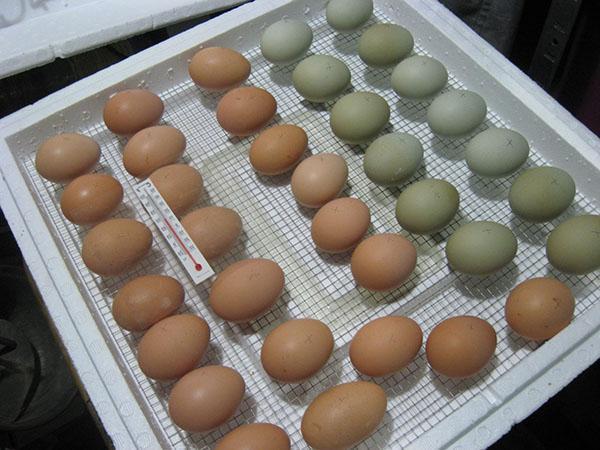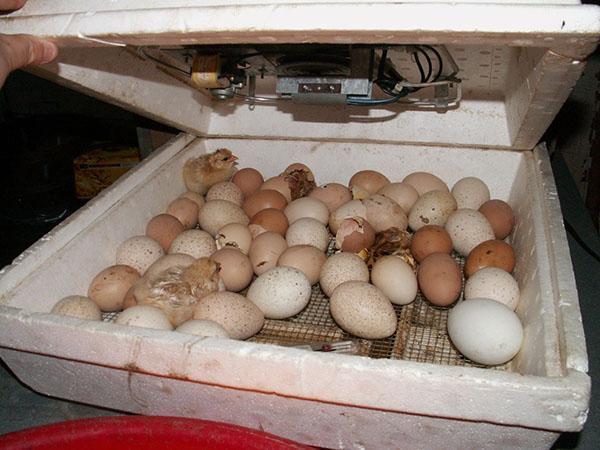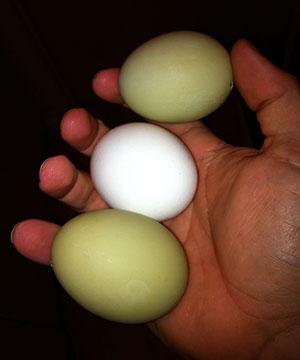Laying eggs in an incubator at home
 Having a home incubator is a real opportunity to get a strong healthy livestock of poultry. However, the quality and quantity of hatched chicks is largely determined by the correct laying of eggs in the incubator at home. This important procedure is preceded by a strict selection of the eggs intended for hatching, as well as the study of the peculiarities of incubation of a particular type of bird.
Having a home incubator is a real opportunity to get a strong healthy livestock of poultry. However, the quality and quantity of hatched chicks is largely determined by the correct laying of eggs in the incubator at home. This important procedure is preceded by a strict selection of the eggs intended for hatching, as well as the study of the peculiarities of incubation of a particular type of bird.
Since the setting and all further processes imitate natural incubation, the last circumstance is most important. Depending on which bird's egg should get into the incubator, it depends:
- temperature and humidity conditions in the incubator;
- terms of incubation and hatching;
- ventilation and cooling features;
- layout methods;
- terms of additional transillumination of eggs to the embryo.
The most close attention is paid to the selection of high-quality eggs, and it is necessary to control the growth and formation of embryos inside not only at the preliminary stage, but also during the incubation process. Eggs without signs of development are removed so as not to provoke the growth of pathogenic microflora and not to potentially endanger the remaining eggs.
What kind of eggs can I put in an incubator? How to identify non-viable eggs by appearance and other signs and remove them from the incubator in time?
How to check eggs in an incubator for embryo?
At the initial stage, the selection of eggs is carried out by external signs. Before laying eggs in the incubator, they are sorted according to their shape, size, and shell quality.
The shell must be intact, even, without pronounced sagging or unformed areas. Eggs with micro cracks or unusual marble-like stains on the surface should not enter the incubator.
 Most often, such defects are difficult to identify visually, therefore, an ovoscope or a household lamp is used to cull eggs. Translucent eggs even before placing them in the incubator allows:
Most often, such defects are difficult to identify visually, therefore, an ovoscope or a household lamp is used to cull eggs. Translucent eggs even before placing them in the incubator allows:
- to recognize unfertilized, long-lying and already non-viable eggs;
- see all the smallest shell defects;
- determine the location and size of the air chamber required by the chick in the last days before hatching.
In eggs suitable for hatching, a well-formed yolk is clearly visible against the background of a transparent protein without foreign inclusions, darkening or cloudy spots. The yolk is located in the center of the egg, and when rocking and turning it slightly shifts from its place.
 The shell must be free from defects on visual inspection and in light. Marbling is especially dangerous, since pathogenic bacteria, viruses and molds can penetrate through poorly formed areas.
The shell must be free from defects on visual inspection and in light. Marbling is especially dangerous, since pathogenic bacteria, viruses and molds can penetrate through poorly formed areas.
The air chamber is located under a blunt dome in its center or slightly lower. If the volume of air inside the shell is large, this may be a sign that the egg has been waiting too long to be sent to the incubator, and its contents have dried out. Such eggs are rejected on a par with unfertilized and spilled fuzzy yolk.
 How to check for embryo eggs in an incubator? In addition to the initial check of the quality of the eggs, during the entire period of incubation, another 1–2 such procedures are carried out with an interval of about a week.Already 5-6 days after the eggs are laid in the incubator, at home, using an ovoscope or an ordinary powerful lamp, you can see a network of blood vessels that penetrate the protein and the dark spot of the embryo.
How to check for embryo eggs in an incubator? In addition to the initial check of the quality of the eggs, during the entire period of incubation, another 1–2 such procedures are carried out with an interval of about a week.Already 5-6 days after the eggs are laid in the incubator, at home, using an ovoscope or an ordinary powerful lamp, you can see a network of blood vessels that penetrate the protein and the dark spot of the embryo.
How do I lay eggs in the incubator?
Eggs of all bird species must be kept cool until they are set in the incubator. If they are immediately transferred to trays and placed in a heated chamber, condensation will begin to form. As a result, the microclimate will be disturbed, mold will develop and the embryo may die.
Therefore, before placing goose eggs or eggs of other poultry in the incubator, they are kept at a temperature of about 25 ° C in a draft-free room for 8-12 hours.
During this time, the temperature inside and outside the shell levels off, after which the eggs can be laid out on trays. The location of eggs in the cells depends on their size, number, and also on the type of bird.
 How to put chicken eggs in the incubator correctly? Chickens are the most frequent inhabitants of backyard poultry houses, therefore, all the nuances of incubating their eggs always excite both experienced and especially novice poultry farmers.
How to put chicken eggs in the incubator correctly? Chickens are the most frequent inhabitants of backyard poultry houses, therefore, all the nuances of incubating their eggs always excite both experienced and especially novice poultry farmers.
A chicken egg is not the largest, so it can be laid on trays, both vertically and horizontally, if there is no shortage of free space. If chicks of a larger bird are to be obtained, then it is advisable, in order to save money, to "put" the eggs on the pointed end or tilt a little. However, the best hatching results are precisely when the eggs are horizontal, which warm up better, are less crowded, and are easier to follow.
Features of laying eggs and care during incubation
 Experienced poultry farmers try to put eggs close in size on one tray. At the same time, you should not place eggs of different types of birds next to each other, even if they are completely identical in weight, size and shape. If chicken eggs are loaded at the same time, geese and other poultry, it is necessary to take into account the different incubation times and, accordingly, different conditions at each stage.
Experienced poultry farmers try to put eggs close in size on one tray. At the same time, you should not place eggs of different types of birds next to each other, even if they are completely identical in weight, size and shape. If chicken eggs are loaded at the same time, geese and other poultry, it is necessary to take into account the different incubation times and, accordingly, different conditions at each stage.
First, the largest ones should go to the trays, then medium and small eggs are laid out in decreasing size. The average interval between bookmarks is four hours.
They do the same when incubating different types of poultry. In this case, you can focus on the average time from laying to hatching of chicks:
- 17 days for quails;
- 21 days for chickens;
- 26-28 for turkeys;
- 26–34 days for different breeds of domestic ducks;
- 28–33 days for geese.
At home, laying eggs in the incubator is carried out manually. The device is preheated to a predetermined temperature, the eggs are treated with an antiseptic solution or using an ultraviolet lamp. It is absolutely impossible to wash and mechanically clean the shell!
 All eggs in the incubator should be evenly heated and ventilated. Therefore, some models have an automatic egg-turning mechanism. If such a function is not provided, the poultry farmer performs a do-it-yourself turnover of eggs in the incubator 10-12 times a day. This technique will provide not only warming up, but also the correct position of the embryo.
All eggs in the incubator should be evenly heated and ventilated. Therefore, some models have an automatic egg-turning mechanism. If such a function is not provided, the poultry farmer performs a do-it-yourself turnover of eggs in the incubator 10-12 times a day. This technique will provide not only warming up, but also the correct position of the embryo.
A week after laying the eggs, it is recommended to check them for the embryo in order to remove the stunted eggs in time and exclude bacterial infections from the spoiled egg. After another 6-7 days, the procedure is repeated.
For beginner poultry farmers, it will be useful to watch a video on how to lay eggs in an incubator. Since the success of incubation is 80% of competently conducted egg selection and laying, then knowing all the nuances of the nuances will help to avoid many mistakes that threaten the death of chicks.
Great review, thanks!